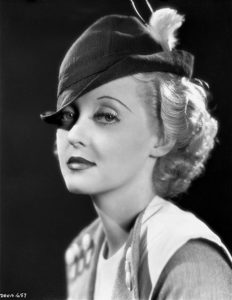
Bette Davis seemed an unlikely female star for Hollywood’s Golden Age. With her heavy lidded eyes which seemed too large for the rest of her face, she was not classically beautiful. Her voice was harsh. Her acting, by her own admission, was affected. ‘Natural!” she said. ”That isn’t the point of acting….Did I ever try to be low-key? Never, never, never! I fought that from the beginning. I think that acting should be larger than life.”
Perhaps it was that larger than life quality that explains her success. Although small in stature, Bette Davis demanded attention on screen. She was not subtle or demure. Instead, she was was defiant. After beginning her career on Broadway and struggling to find her footing in films, the role that finally gained her fame was the rotten-hearted Mildred in 1934’s Of Human Bondage. Watch her humiliate poor, crippled Philip (Leslie Howard), shrieking her contempt for him, and you’ve already got a good glimpse of the career that was ahead of Bette Davis. She would play many women who treated men with contempt; and she would shriek often.
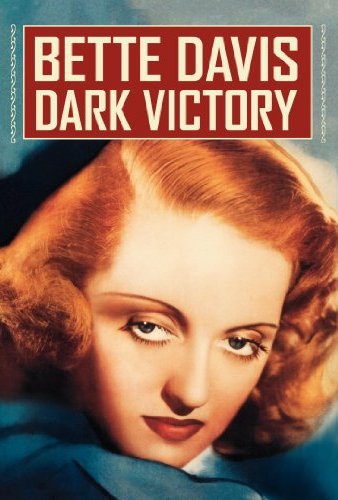
The strong personality and fierce temper weren’t confined to the screen. Bette Davis was determined to exercise agency in her career at a time when studio contracts kept actors and actresses tightly under control. Davis sued Warner Brothers in 1937, unhappy with the roles she was being given and desirous of going to England to do movies outside her contact. She lost the case but somehow won the respect of Jack Warner, who finally gave her the kind of roles she’s been seeking. The next several years were her most successful, starring in a series of films that were both critically acclaimed and box office successes: Jezebel, Dark Victory, The Private Lives of Elizabeth and Essex, The Little Foxes. There were ups and downs ahead, some of the downs connected to Davis’s challenging temperament. ‘I was a legendary terror,” her obituary in the New York Times quoted her as saying. ”I was insufferably rude and ill-mannered in the cultivation of my career. I had no time for pleasantries. I said what was on my mind, and it wasn’t always printable. I have been uncompromising, peppery, intractable, monomaniacal, tactless, volatile, and ofttimes disagreeable. I suppose I’m larger than life.”
It was to Bette Davis’s credit, however, that she was able to recreate herself on screen more than once. After a decline in the late 40s she came back with perhaps the greatest performance of her entire career, as Margo Channing in All About Eve (1950). As an aging, vain, insecure stage actress – an actress who is never quite stops acting, even in her personal relationships, Davis is absolutely dynamite. The memorable line, “Fasten your seatbelts: it’s going to be a bumpy night,” would be much less memorable without Bette Davis’s arch, brittle, jaded line delivery.
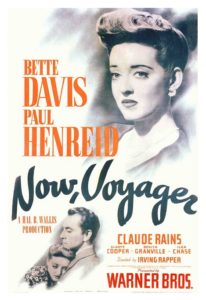
Another stage in Davis’s career began in 1962 when she starred opposite Joan Crawford in Whatever Happened to Baby Jane? The film energized a sub-genre of horror – Grand Dame Guignol, or, more crudely, Hag Horror or Hagsplotiation – which served as vehicles for fading female actresses. Davis starred in several of these; not just Baby Jane, but Dead Ringer; Hush, Hush, Sweet Charlotte; and The Nanny. It was Davis’s utter commitment in these roles that made her such a good fit. Her piercing voice had only grown harsher over the years, her face stranger. A more insecure actress might have balked at being made to seem hideous, as Davis certainly is in Whatever Happened to Baby Jane? Bette Davis seemed to relish the opportunity.
Late in her life Bette Davis was a ubiquitous pop culture, one of the quirky figures like Truman Capote and Tiny Tim who showed up frequently on talk shows – perhaps largely to be gawked at for their oddity as much as admired for any accomplishments. Her voice and mannerisms were ripe for mimicry. Even now I can hear her in my head: “What a dump!” “But ya ARE, Blanche! Ya ARE in that chair!” Other actresses may have been more glamorous, but no one was more distinctive or memorable; no one more fiercely committed to doing things her own way, than Bette Davis.
– Sharon Autenrieth
All About Eve
1950, Twentieth Century-Fox Film Corporation, dir. Joseph L. Mankiewicz
by Taylor Blake
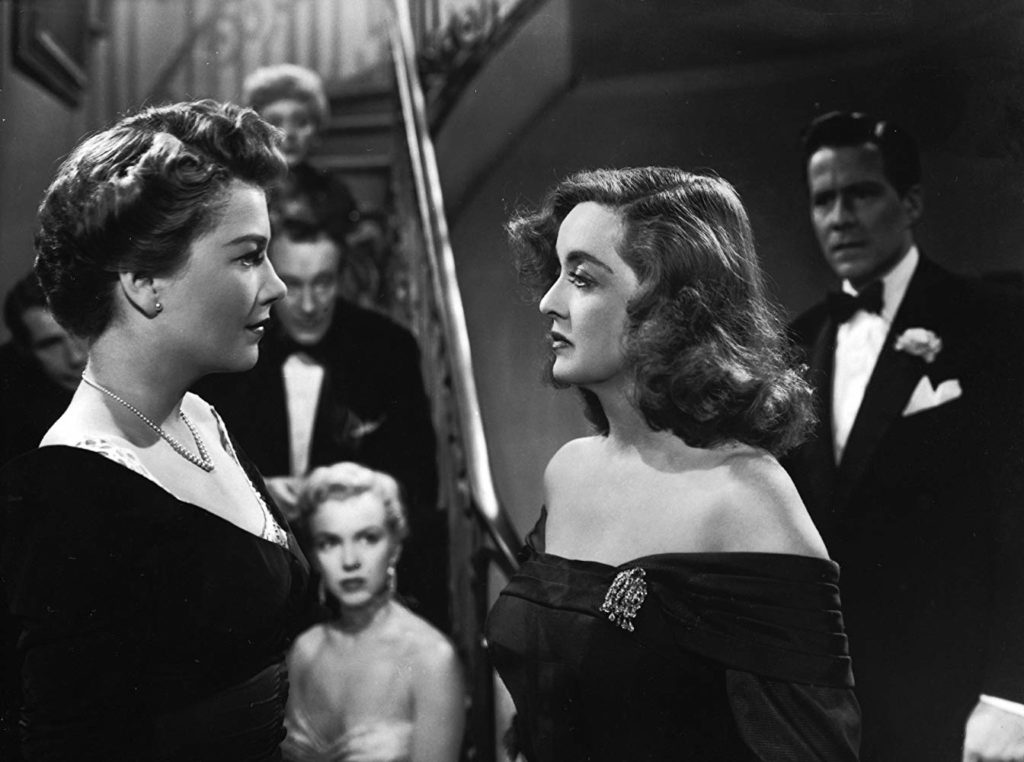
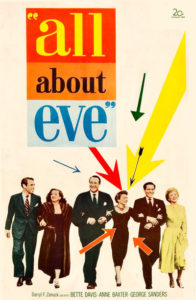
As this is my first outing with Bette Davis, any of her films could have been a winner of a Film Admission, but why not start with the biggest whopper of them all? All About Eve, the 14-time Oscar nominated (6-time winning) film starring the 11-time nominated (2-time winning) Davis, is as grand an opera of showbiz as all those accolades suggest. Talent, influence, and jealousy forge into a juicy struggle of mind games and power plays, yet somehow it’s not about the power or even the money. It’s all about artistic integrity, but even more, all about love.
No one is more insecure about Margo Channing’s age than Margo Channing herself (Davis), so when a young, starry-eyed idolater named Eve Harrington (Anne Baxter) comes to worship at her feet, she doesn’t sniff at her praise. She soaks it up, takes Eve under her wing, and soon watches her deepest insecurities actualize into a new, rising theatre star.
Never mind that we never see Eve Harrington on stage—Baxter plays a performance within a performance, and she plays Margo and her friends like enraptured critics. She expects everyone to be as corrupt as her, but no one as smart, which is why Margo’s transformation into one who can accept aging gracefully all the more poignant. Just like Eve, we expect her to return every bite for bite, every snip for snap, so when she doesn’t, well, that’s a twist this melodrama never saw coming. All of the reality TV-style backbiting gives way to a gracious maturity, one not grasping for love even though no cameras are rolling and the audience has left.
With a plot like that, you might compare this Best Picture winner to this year’s nominee, The Favourite. Both center on feminine battles over popular authority and psychological torture, but Davis’s convincing transformation is what makes All About Eve stand with her wide-eyed head and bare shoulders above this and other stories like it. With an introduction like this one, you can bet I’ll be back for more.
Jezebel
1938, Warner Bros, dir. William Wyler
by Jeffrey Knight
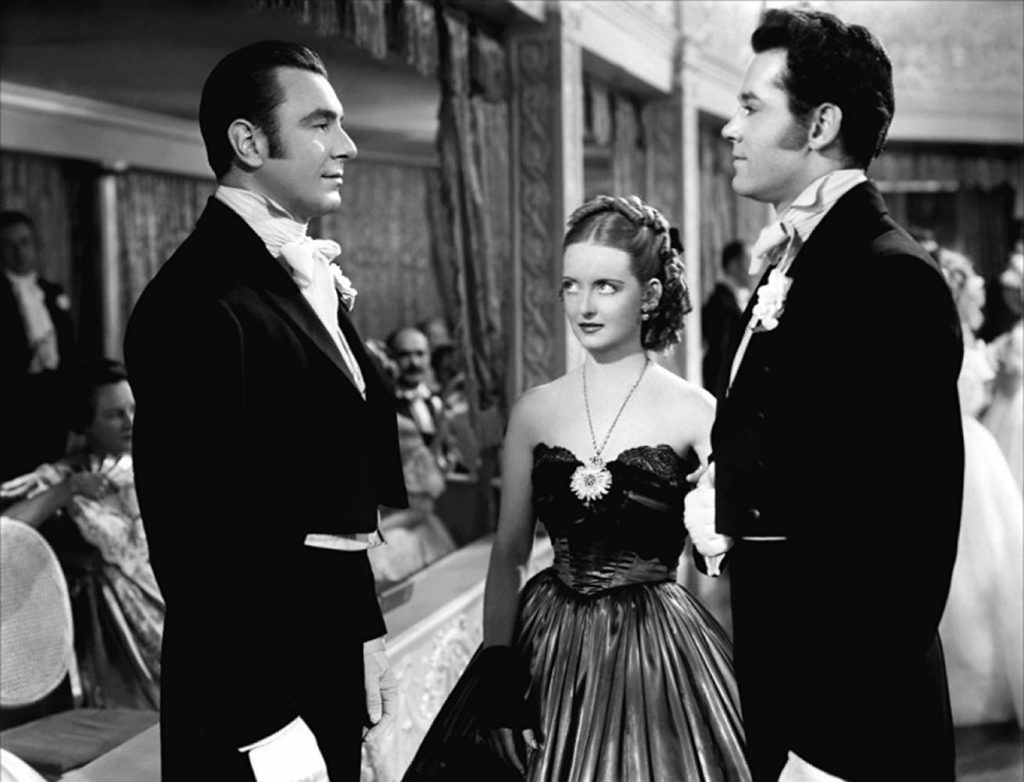
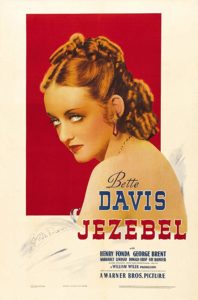
She comes charging into the movie, riding sidesaddle on a high-spirited horse. She’s late for her own party, and while she realizes that’s a faux-pas, she isn’t bothered by her guests’ reactions. She is Julie Marsden, an ante-bellum Southern Belle who knows what she wants and is determined to have it. She is Bette Davis.
Davis plays Marsden in Jezebel. Directed by William Wyler and released in 1938, the movie is set in New Orleans in the 1850s. It tells the story of Julie’s relationship with Prescott Dillard (Henry Fonda). Dillard and Julie are engaged to be married, but her headstrong and free-spirited ways threaten to cause a rift in their relationship. Julie doesn’t conform to her society’s notion of how a young woman should act, and she lashes out when she’s pressured to do so. Dillard is a young banker who’s more socially conservative, and if Julie doesn’t feel scandalized for how she acts in public, he feels more than enough for the both of them. Writing this out, it makes Jezebel sound like screwball comedy gold, and it’s a shame Davis and Fonda never got the chance to make one together.
As pure Southern Melodrama, Jezebel is packed with plenty of plot. Over the course of its 104 minutes, there will be balls, duels, plagues, surprise marriages, plotting, conniving and rumblings of war. The movie hurdles along from plot point to plot point, with hardly a moment to spare. But all these story beats in Jezebel allow for Davis to show plenty of range. This was certainly a draw for her, as Davis intentionally chased after roles that would challenge her skills.
Davis won her second of two academy awards for her portrayal of Julie. At first blush, it does seem to be the quintessential Bette Davis role: a, tough, independent woman who isn’t afraid to call out other people’s nonsense when she sees it. However, that’s just the first half of the film. As the story unfolds, Julie will prove to be more spoiled than tough, and more needy than independent. She connects her self-worth to Dillard’s love and affection, and when she thinks she has lost him she vows to stop at nothing to get him back. Julie morphs from someone to admire into a petty villain. At the end of the film, she makes a sudden sacrifice in a bid to regain some nobility, but it comes too quickly and too close to the end to feel earned.
Some rumors have it that she was given the part in compensation for not being cast as Scarlett O’Hara in Gone With the Wind, while others say that Jezebel’s existence so infuriated David O. Selznick, that he refused to even consider Davis for the part. Which is true? Whichever makes for the better story I suppose.
Mr. Skeffington
1944, Warner Bros., dir. Vincent Sherman
by Robert Hornak
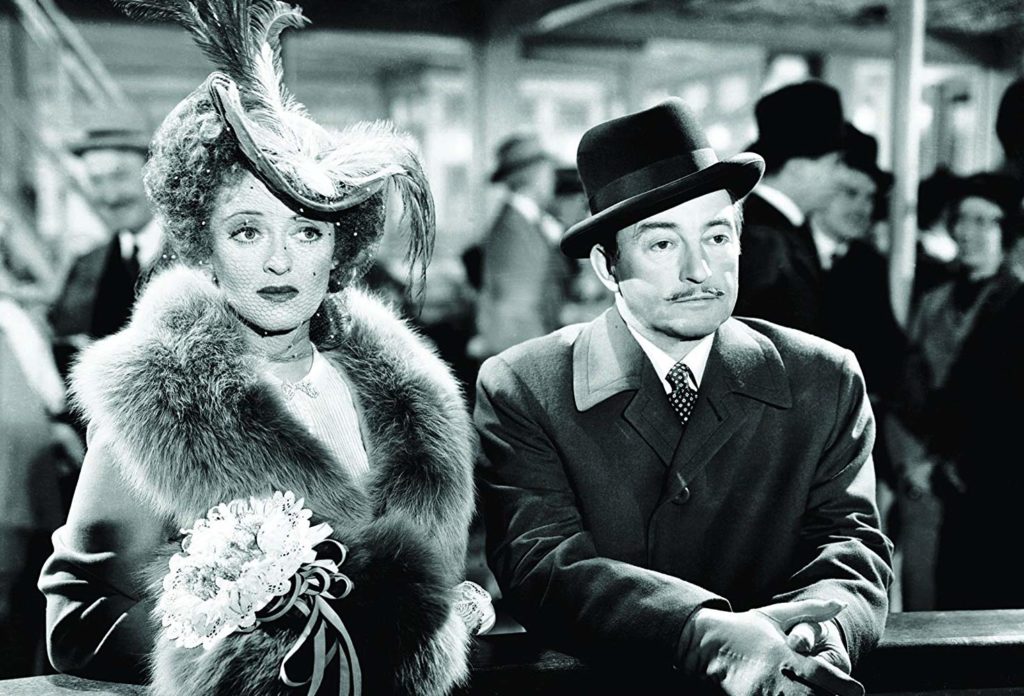
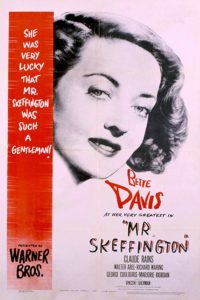
“A woman is beautiful only when she is loved.” This is the dubious ruling principle unfurled and tested by the melodramatic plots and pains of Fanny Trellis, a romantically sought-after, pre-WWI socialite whose brother absconds with $24K from Job Skeffington’s Wall Street firm. Hoping it’ll spare him from litigious retribution, she tears up her dance card and marries the confirmed bachelor Skeffington, rendered in shades of Claude Rains’s typical sonorous charm. He’s the reason I picked this movie – the king of the side-eye, the short guy with the lifts and the high tide of hair, whose manner and charm swallow scenes whole. As the longsuffering Skeffington, he’s fully aware he’s being played, but is so in love with her – in fact, the only one who truly loves her – he suffers the Hosea-like indignity of watching her return over time to her naturally promiscuous nature. The back half of the film riffs on the soft/hard tonal conflict of Skeffington’s quiet gravitas and Fanny’s eventual shrewish sniping, a dynamic that kept Davis and Rains a go-to team-up for Warner Bros over four films.
For me, Davis as the reigning ingénue of 1920s New York City is a bit hard to accept, despite the insistent wooing refrain of her ever-orbiting gentlemen callers. Even after marrying Skeffington, her alleged beauty is so (fictionally) intense that she has to bat them away during scheduled interviews. Said Davis in a 1971 interview with Dick Cavett: “Actors should look like we’re working at least a little.” I think maybe she never had to work as hard as she did in this movie. At 36, she shoulders the film’s ambitious timeline from ingénue to aged, eventually trading in her wide-eyed, bird-chirping innocence (not convincing to me in the least) for the glorious, staccato bitchiness of her character’s old age, one that uncannily predicts her real-world future-self right down to half-mast eyes, recoiling entitlement, and those erect fingers vice-gripping a lit cig pointing straight behind to everywhere she’s tapped the ashes.
But the lack of typical Hollywood looks is part of the marrow of the movie. There’s a recurring call-back to a near-floor-to-ceiling painting of young Fanny, commissioned early in the film by Skeffington, that just keeps staying young as time batters her face and body into submission, like a reverse Picture of Dorian Gray. Late in the film, Fanny contracts diphtheria, a disease that wrecks whatever beauty hadn’t been ravaged by time itself, and it chafes the perpetual self-delusion encouraged by that painting. She refuses to believe she’s anything less than desirable until the slow, steady dawning of her own mortality, buttressed by that remarkably prescient makeup, forces a humble break into reality, and we get the single poignant purpose of the entire 2.5-hour journey. If there’s a hiccup in the rollout of this epiphany, it’s when the by then long-gone Skeffington returns to his only beautiful love – but has been blinded in war, so he can’t see her, twisting the film’s mantra into “a woman is beautiful only when her wrinkles can’t be seen.” The movie has reverted instantly back into Hollywood dogma.
Deception
1946, Warner Bros., dir. Irving Rapper
by Jim Tudor
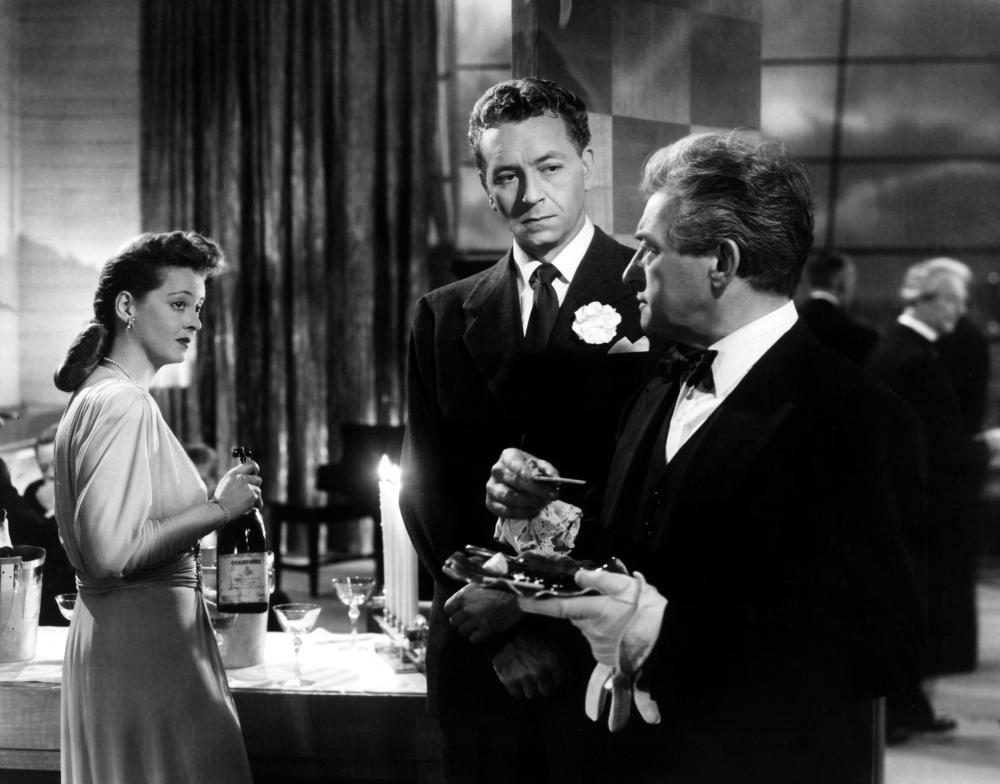
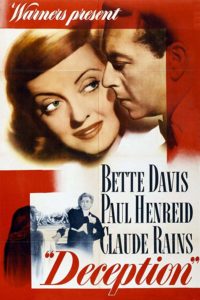
It’s hard to imagine that Damien Chazelle wasn’t at least in some small part inspired by Deception when he was hashing out his own symphony-based battle of the wills, Whiplash. Straight outta 1946 Warner Brothers, Deception is, as DVD commentator Foster Hirsch puts it, a Film Noir, a women’s picture, but first and foremost, a Bette Davis vehicle. Davis’ character, Christine Radcliffe, dominates the mechanics of the plot, it’s true. But it’s the steamroller-like presence of Claude Rains that one rememberers. His character, Alexander Hollenius, a ridiculously wealthy classical music maestro, is (to go back to Whiplash) the J.K. Simmons’ Fletcher of the film, always belittling, posturing, ranting, and casting about his power in self-aggrandizing, damaging ways. Were it not for Rains’ portrayal- one that doesn’t debut until twenty-four minutes into Deception, and completes a good ten minutes prior to the closing title card, the movie would be 100% forgettable.
That’s not to say that Deception is a poorly made film, or even a lousy one. It’s just rather inert. It scores big points for its powerhouse showcasing of the orchestral performances, anchored by the the appropriately imposing music of Erich Wolfgang Korngold. Directed by the notoriously rebellious WB contract filmmaker Irving Rapper (Marjorie Morningstar), Deception is visually engaging, particularly in terms of its moody black and white photography. Rapper earns his reputation as a rabble-rouser by allowing his film to end without justice being properly served- a Morion Picture Production Code violation at the time.
Unfortunately, all of that makes Deception sound more engaging than it is. Davis, at the end of her superstar run, spends the film juggling two men with whom she’s intimately tied. The first, her soulmate played by Paul Henreid, throws her for a joyous loop when he returns to her after she assumed him dead in their humble life overseas. Now living a life of luxury in the U.S., she marries him and uses her newfound connection in the classical music world to land him a high profile job as a star cellist. The connection, though, is the intensely possessive Hollenius. Tensions ensue. Meanwhile, we learn that Christine never really broke it off with Hollenius, who’s thrown for a horrifically jealous loop when she suddenly marries this resurfaced ace cello player.
The deceptions in Deception aren’t gotcha/twists, but rather conventionally dramatic plot points; a serious love triangle of three people, none of whom are at all likable. Though the marketing boast is that Deception marks a reunion of the cast and director of Now, Voyager, Davis simply seems rung out and bored here.
What Ever Happened to Baby Jane?
1962, The Associates & Aldrich Company, dir. Robert Aldrich
by Erik Yates
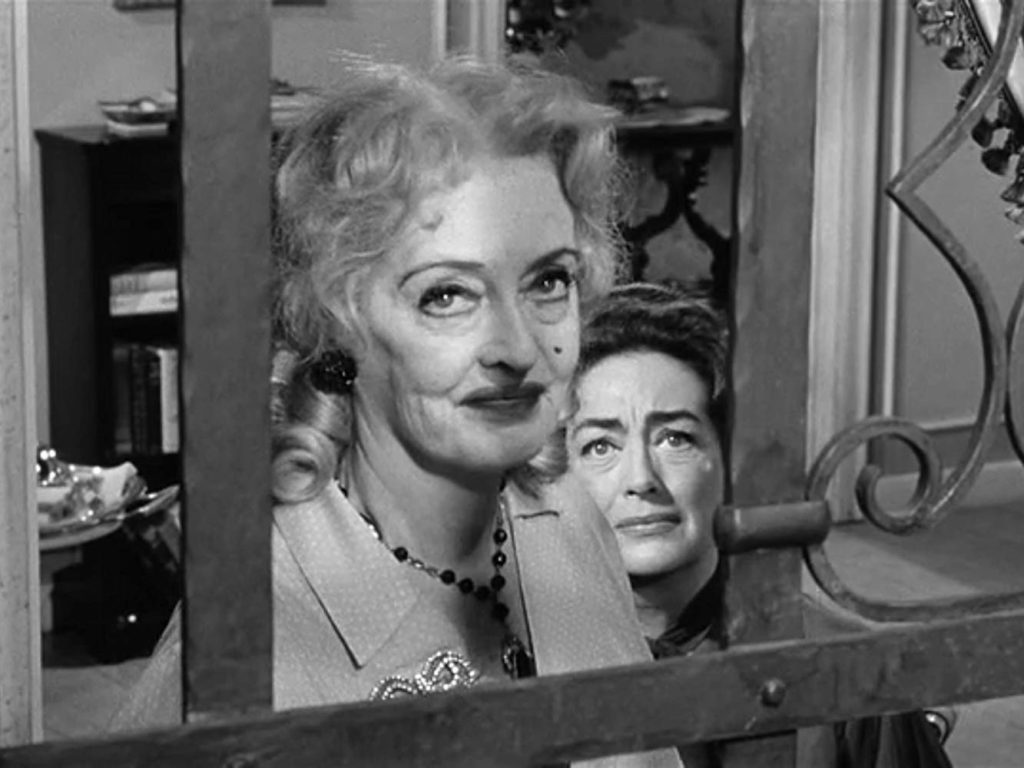
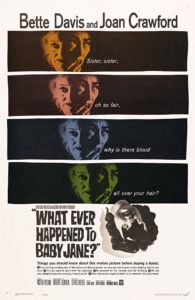
I, admittedly, have many holes in my Bette Davis filmography, but I ended up choosing to fill one of those holes for this month’s film admission category by watching the Robert Aldrich directed film, What Ever Happened to Baby Jane? (1962). This film was absolutely fascinating, and enhanced given the recent series Feud, which famously chronicles the hateful relationship between Davis and her Baby Jane co-star, Joan Crawford. As I watched this horror-drama, I found myself extremely interested in putting Feud into my queue.
What Ever Happened to Baby Jane? chronicles the fall from grace of child performer Jane Hudson. In 1917, in the days of vaudeville and long before the dawn of television, Baby Jane booked sold-out shows to packed audiences who couldn’t get enough of her song and dance routine, or her creepy pre-Annabelle-like replica dolls that were sold after each performance. She was a diva in every way, constantly putting down her sister Blanche. Fast forward 17 years and Blanche is the toast of Hollywood. A certified movie star, Blanche does not use her celebrity to get even with Jane, who isn’t finding the same success as an adult, that she did as a child. Following a nearly fatal car accident that leaves Blanche as a paraplegic in a wheel-chair, completely dependent on Jane to bring her food, and to care for her. Now in their 50’s, Jane is a drunk, paranoid, and completely jealous of her sister’s ongoing success years after quitting the business following her accident. Blanche’s films continue to be shown on television, and no one remembers Baby Jane. As Jane’s bitterness grows, a sibling rivalry develops that is downright sinister, resulting in an effective story that still draws you in, nearly 60 years later.
Davis is completely over the top, without ever letting her performance become a caricature. Instead, she is deeply tortured, and simultaneously cruelly-calculating and emotionally stunted. Her view of her sister is very much grounded in a child’s view of favoritism and jealously, though her ways of dealing with it are a web of manipulation, and drunken-rage. Bette Davis shows off those Kim Carnes’ song-inspiring “Bette Davis Eyes”, as she lashes out at Blanche who is played wonderfully by Joan Crawford. If their hatred for each other in real-life fueled such a wonderfully collaborative performance that fed off of that hatred, it’s a shame that this was their only shared film together. Do yourself a favor and check this one out whenever you find it.
Hush… Hush, Sweet Charlotte
1964, The Associates & Aldrich Company, dir. Robert Aldrich
by Sharon Autenrieth
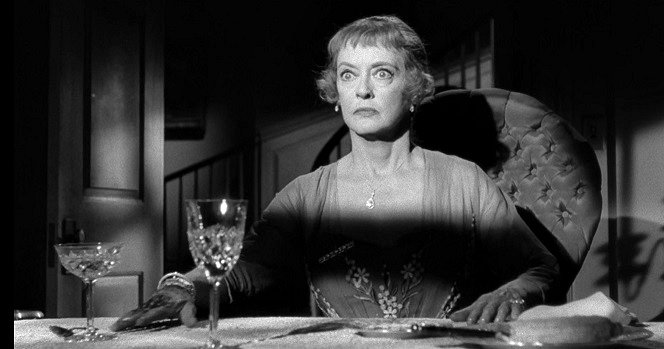
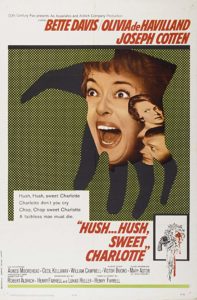
Two years after creating the the horror classic Whatever Happened to Baby Jane, director Robert Aldrich reunited with Bette Davis to try to capture the same magic. Hush, Hush, Sweet Charlotte is spooky, campy, graphically (if not convincingly) violent, and like Baby Jane, it pits Davis opposite another aging actress. This time, it’s Olivia de Havilland playing kind, supportive cousin Miriam in contrast to Davis’s high camp Charlotte, a decaying southern belle living in a decaying southern mansion, haunted (literally, perhaps?) by her murdered lover.
Hush, Hush, Sweet Charlotte is a strange movie in which there are obvious flaws alongside beautiful touches. It sometimes rises higher than you’d expect, particularly in the expressionist camera work of cinematographer Joseph Biroc. Davis’s performance is exactly what is required in this sort of Grand Dame Guignol: completely over the top. As a woman who has long been suspected of murder but who (as the sheriff suggests) is far less crazy than she wants people to believe, she rages, whimpers, shrieks, and conspires in an effort to keep her condemned home. The movie’s cast is a bounty, offering not just Davis and de Havilland, but Mary Astor, Bruce Dern, Victor Buono, Agnes Moorehead, and the great Joseph Cotten.
Moorehead seems to be having a delightful time playing Charlotte’s devoted but extremely curmudgeonly housekeeper. Cotten is smooth and charming as her personal physician – but we all know that the smooth and charming Joseph Cotten can conceal multitudes. As for de Havilland, she is beautiful and composed, exuding patience and compassion for Charlotte. But there’s an inheritance on the line, a decades-old unsolved murder, more bodies to pile up, and strange, spectral goings-on in Charlotte’s house of haunted memories. Aldrich makes it all lots of fun, and to his credit I didn’t see all of the twists coming. The ending is disorientingly upbeat, all things considered. And then there’s the theme song, used in the film’s title. We don’t see much sweetness from Charlotte, and I prefer the version the neighborhood children sing early in the film: “Chop, Chop, Sweet Charlotte”. It tells you all you really need to know about the kind of movie this is.

